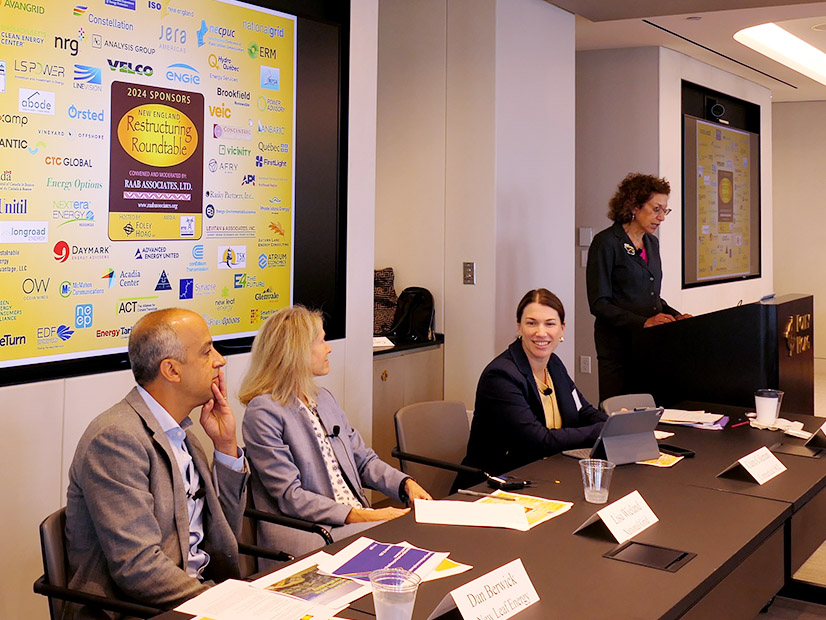BOSTON — Increasing electricity prices must be met with a greater effort to reduce peak loads and protect low- and moderate-income ratepayers, several Northeast utility regulators said at Raab Associates’ New England Electricity Restructuring Roundtable on Sept. 20.
“There is no question that affordability is being strained today,” said Ron Gerwatowski, chair of the Rhode Island Public Utilities Commission, adding that electricity costs are likely to remain high for the foreseeable future.
U.S. Bureau of Labor Statistics data shows the Northeast has some of the highest electricity prices in the country, rivaled only by parts of the West Coast. The costs associated with transmission and distribution system upgrades and grid decarbonization could push rates even higher.
While investments in grid infrastructure and renewable generation may benefit ratepayers in the long-term, Gerwatowski stressed that many customers are “not worried about whether electricity rates will stabilize in the long-term, they’re worried about paying their electricity bills today.”
However, Gerwatowski also emphasized it is “oversimplistic, and not reasonable, to blame the strain on affordability solely upon the costs associated with any one individual initiative, especially our initiatives that are designed to advance renewable energy deployment in order to address carbon emissions.”
He said the region’s rates are being pushed up by inflation, the increasing need to replace aging grid infrastructure, high winter gas costs, utility biases toward capital expenditures and the decreasing availability of easy energy efficiency improvements.
Massachusetts Department of Public Utilities Commissioner Staci Rubin said LNG volatility and reliance on the Everett LNG import terminal also contributes to high rates, along with predatory third-party competitive suppliers.
Rubin said the ratepayer benefits of long-term renewable energy contracts often are not apparent to customers, noting that “things like price suppression do not actually show up on your bill.”
At the same time, “the entire clean energy transition cannot be funded entirely through electricity bills — we need to look for outside sources of funding,” Rubin said, emphasizing the importance of seeking and using all available federal funding.
Maine PUC Commissioner Carolyn Gilbert added that electricity bills are a “somewhat regressive means” to fund the clean energy transition. She said states must push to unlock cost and emissions savings from time-varying rates, echoing similar comments made by Gerwatowski.
“Any time there’s a potential to save money I think we have to go after it,” Gilbert said.
Lisa Wieland of National Grid, which owns electric and gas utilities in Massachusetts, said the company this fall is beginning a multiyear process of deploying advanced metering infrastructure (AMI) in the state. The company expects to bring AMI to between 750 and 1,000 of its approximately 1.3 million customers in the state by the end of the year and plans to roll out time-varying rates once it has completed most of its AMI deployment.
Gas Decarbonization
Reducing the region’s reliance on natural gas is essential to keeping energy costs manageable in the region, said Bradley Campbell, president of the Conservation Law Foundation.
“The energy transition can drive affordability,” Campbell said, adding that “the message that the clean energy transition is antithetical to affordability” is “a false narrative being pushed heavily by the fossil fuel industry.”
While the Massachusetts DPU has ruled the state will need to chart a course off gas to meet its climate goals (DPU 20-80), natural gas consumption in the region for buildings and electricity generation has ticked up in recent years, according to state’s most recent emissions inventory update and data from ISO-NE.
Gas prices remain a key driver of the region’s energy costs, with pipeline constraints driving up gas prices in the winter and leading to expensive out-of-market contracts for LNG. Enbridge, which owns the major natural gas pipeline into the region, has proposed a major project to expand its gas transmission capacity into the region, to the staunch opposition of climate activists.
“In a region where ratepayer misery is driven by gas price volatility, the message that we should double down on natural gas dependency in New England is not only unsound, it’s immoral,” Campbell said.
Disagreements between the Massachusetts Senate and the House over how aggressively the state should move away from gas have derailed progress on a wide range of other climate and energy issues, including a widely agreed-upon proposal to reform the permitting and siting processes for clean energy infrastructure. (See Mass. Gov. Healey Includes Permitting Reform in Budget Proposal.)
“Massachusetts siting reform failed to pass, despite broad consensus, because gas utilities would not agree to take the first steps needed to implement the DPU’s order on the future of gas,” Campbell said. He criticized both the administration of Massachusetts Gov. Maura Healey (D) and the utility industry for not moving more quickly to prepare for the transition away from gas.
At the same time, he expressed optimism about the administration’s newly created Office of Energy Transformation, which he said could “could provide the venue to forge consensus among stakeholders on how to speed the energy transition while advancing affordability.”
Solar Stagnation
Dan Berwick, CEO of New Leaf Energy, expressed concern about the stagnation of solar development in the state, noting that 2023 was “the lowest year for solar deployments in over a decade” in the state, with 2024 tracking to be even lower.
While large-scale solar projects are the cheapest form of solar in the state, “we’ve all but stopped doing big solar projects in Massachusetts,” Berwick said. He attributed the slowdown to interconnection delays and constraints on where solar projects can be sited to receive support from state programs.
“We have a much more restrictive land use framework for our clean energy developments than we do for other types of developments,” Berwick said, also expressing hope that “there’s an outcome that we ought to be able to find alignment on.”
